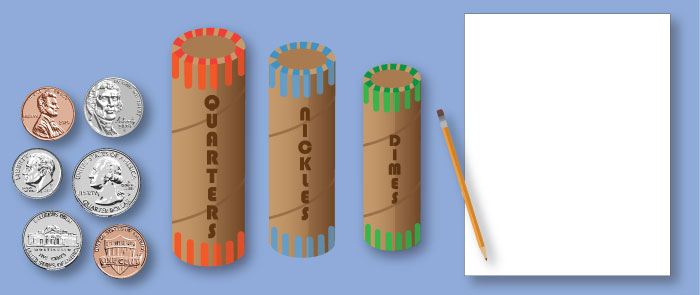
Help get coins moving! Count and roll your coins to prepare them for the bank.
Grades: 2nd grade and up
Materials: coins, coin wrappers (you can get these at a local bank or online), pencil, paper
Time: 30 to 90 minutes
Steps:
1. Gather your materials. Find your change jar or go on a hunt to find coins to roll. Then, grab coin wrappers, which are paper tubes used to make coin rolls. Most banks will accept these coin rolls and will exchange the coins for bills. You will also need a pencil and paper. Make sure you have a flat surface to do this activity.
2. Lay out your coins and sort them by coin type, or denomination. Make one pile for each denomination: quarters, nickels, dimes, and pennies. If you have half dollar or dollar coins, keep these separate. You may not have a coin roll for these or enough coins to fill a paper tube for half dollar or dollar coins. If you aren’t sure what each coin looks like, learn more about them.
3. Make two columns on a piece of paper. Title the left side “Coins” and the right side “Wrappers.” Count the number of coins in each pile. After you count a pile, write down the number of that coin in the “Coins” column. Repeat for each of your piles. Example: Quarters: 63. Nickels: 86. Dimes: 57. Pennies: 93. Half Dollar: 1. Dollar: 3
4. Look at your coin wrappers. How many wrappers do you think you will need for each type of coin? Think about how many coins might fit inside one wrapper. Write your prediction on your paper on the right side next under the title “Wrappers.”
5. Now roll your coins! Pick one coin denomination to start rolling.
- Make sure you have the right coin wrapper! Each wrapper is labeled with the coin denomination (quarter) and how much money a full roll will be worth ($10). This means when you have a full roll of quarters it is equal to $10. Some rolls may also include the value of a coin (25 cents). The value is how much a coin is worth when you use it as money. For example, a quarter is worth 25 cents.
- Take your wrapper and place a few coins inside. Then fold the paper up from the bottom of the wrapper to seal it so that coins do not come out of the bottom. Now continue adding coins until the wrapper is almost full. Make sure you have a little bit of paper at the top of the wrapper to fold over to seal the roll. The wrapper should be closed on both sides. Set your full coin roll aside and continue filling the other wrappers.
Note: if you do not fill a wrapper all the way, you can always keep adding to it later when you have more coins. We will only count full coin rolls for this activity.
6. How many wrappers did you use for each denomination? Count how many full rolls you have and compare it to your prediction. How close were you? Write down your actual number of wrappers next to your guess.
- Bonus question – Can you figure out how many coins fit inside each full wrapper? Hint – If your coin wrapper tells you how much money you have with one completed roll (e.g., one roll of pennies equals 50 cents), you can work backwards to figure out how many coins it takes to reach the total. Think of it this way – if one penny is equal to one cent, how many pennies does it take to make 50 cents?
7. Now it’s time to find out how much money you will get back from the bank. Flip your paper over.
If you figured out the bonus question above, you know that there are:
- 40 quarters per roll
- 50 dimes per roll
- 40 nickels per roll
- 50 pennies per roll
On your paper, write down how much money you have for each denomination. Then add up or multiply that value by the number of rolls you have. Do not count any half-full or partially-full coin rolls.
Example: One roll of pennies equals $______ . I have four rolls of pennies. I have $_________.
Then add up all the denominations to figure out how much money you have in total!
8. Go with an adult to the bank. You can exchange the full rolls of coins for bills or add the money to a savings account so you can spend it later.
You helped put coins back into circulation – they aren’t stuck in your change jar anymore! Other people and businesses will be able to use the coins after they leave the bank. Plus, you added money to your pocket or your savings account. Pat yourself on the back!
